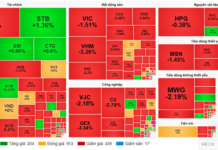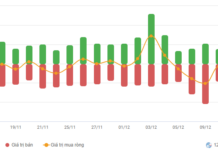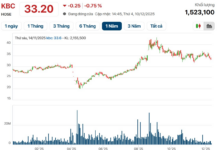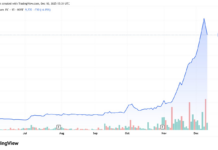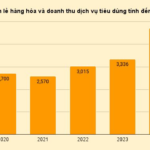According to the report from the General Statistics Office, the rise in electricity prices for household use, rental prices, and housing maintenance materials were the main factors contributing to a 0.13% increase in the CPI for November 2024 compared to the previous month. In comparison to December 2023, the CPI for November increased by 2.65%, and by 2.77% year-on-year. On average, for the first eleven months of 2024, the CPI increased by 3.69% year-on-year, while core inflation rose by 2.7%…
Out of the 0.13% increase in the CPI for November 2024 compared to the previous month, there were eight groups of goods and services with rising price indices and three groups with decreasing price indices.
The eight groups of goods and services that experienced an increase in their price indices are as follows:
The group of housing, electricity, water, fuel, and construction materials witnessed the highest surge, with a rise of 0.87%. This increase was primarily driven by hikes in the following items: firewood prices increased by 3.57% compared to the previous month due to price adjustments during the month; gas prices went up by 2.25% from November 1st, 2024, as domestic gas prices followed the upward trend of global gas prices; home repair services became more expensive, rising by 0.62% due to heightened demand during the year-end; rental prices climbed by 0.45% as a result of higher prices in the real estate market for houses, land, and apartments; housing maintenance material costs rose by 0.28% due to increases in cement and steel prices, compounded by rising electricity, coal, and packaging costs; and lastly, household electricity prices increased by 2.03% month-on-month due to adjustments in retail electricity prices by the Vietnam Electricity Group (EVN) starting October 11th, 2024.
On the contrary, water supply prices decreased by 0.43% as the transition to winter weather led to reduced consumption.
The group of other goods and services witnessed a price index increase of 0.29%. Specifically, jewelry prices rose by 2.35% in tandem with domestic gold prices; watch repair services became 0.12% more expensive; personal care services prices increased by 0.1%; and environmental sanitation services prices went up by 0.07%.
The group of beverages and tobacco experienced a price index increase of 0.26%, largely driven by rising production material costs and an appreciation of the US dollar. To be more precise, fruit juice prices rose by 0.52%; carbonated soft drinks became 0.45% more expensive; mineral water prices increased by 0.42%; tobacco prices climbed by 0.33%; liquor prices went up by 0.29%; and beer prices rose marginally by 0.1%.

Source: General Statistics Office.
The group of clothing, hats, and footwear saw a price index increase of 0.21% due to rising labor costs, material costs, and increased demand as the weather changed. Specifically, shoe services became 0.5% more expensive; fabric prices rose by 0.41%; clothing services increased by 0.27%; ready-made garments became 0.23% pricier; and hat prices climbed by 0.22%.
The group of culture, entertainment, and tourism witnessed a 0.2% increase in its price index, mainly driven by items such as newspapers, which became 0.66% more expensive; movie and music show tickets rose by 0.47%; potted plants and flowers increased in price by 0.41%; sports services became 0.29% pricier; and children’s toys experienced a price hike of 0.18%.
Education services saw a modest increase of 0.11% in their price index. This was driven by a 0.11% rise in the price of educational services, as some private kindergartens, colleges, vocational schools, junior colleges, universities, and postgraduate institutions raised their tuition fees. Additionally, Thai Nguyen and Dong Thap implemented policies to waive or reduce tuition fees to support their residents. Apart from that, paper product prices rose by 0.28%; stationery and other school supplies became 0.23% more expensive; and writing instrument prices increased by 0.18%.
The group of household appliances and utensils experienced a price index increase of 0.08% due to heightened demand during the wedding season and the transition to winter. Specifically, plastic and rubber goods became 0.51% more expensive; renting household items rose by 0.49%; gas stoves increased in price by 0.32%; other electrical appliances, along with beds, cabinets, and tables and chairs, all experienced a price hike of 0.29%; bathroom water heaters and kitchen equipment witnessed a similar increase of 0.23%; home appliance repair services became 0.18% pricier; voltage stabilizers for electricity rose by 0.14%; hiring domestic servants became 0.11% more expensive; indoor textiles increased by 0.1%; and glass, porcelain, and ceramic goods prices climbed by 0.18%.
The group of medicine and healthcare services saw a modest increase of 0.05% in its price index due to seasonal changes and an increase in flu and respiratory illnesses during the transition to colder weather. This led to higher demand for painkillers, fever reducers, respiratory medications, vitamins, and mineral supplements. Specifically, painkillers and fever reducers became 0.27% more expensive; digestive system medications rose by 0.12%; cardiovascular drugs, and vitamins and mineral supplements, both experienced a price hike of 0.07%.
Three groups of goods and services experienced a decrease in their price indices:
The group of transportation saw a price index decrease of 0.07%. This was driven by a reduction in air passenger transport prices by 11.04%; a 4.1% drop in rail passenger transport prices due to lower demand; a 0.14% decrease in gasoline prices compared to the previous month; a 0.13% drop in prices for used cars; and a slight 0.04% decline in prices for new cars.
On the other hand, some items within this group became more expensive: diesel oil prices rose by 2.96% due to price adjustments during the month; lubricating oil prices increased by 0.1%; motorcycle repair services became 1.03% pricier compared to the previous month; bicycle repair services rose by 0.55%; motorcycle spare parts became 0.27% more expensive; motorcycle tires and inner tubes experienced a price hike of 0.25%; motorcycles became 0.24% pricier; bicycle tires and inner tubes rose by 0.21%; bicycle spare parts increased by 0.15%; and bicycles became 0.14% more expensive.
The group of food and catering services witnessed a price index decrease of 0.22%. Within this group, the price index for cereals rose by 0.33%; food prices dropped by 0.5%, contributing to a 0.1-percentage point decrease in the CPI; and the price index for dining out increased by 0.26%.
The group of postal and telecommunications services experienced a price index decrease of 0.3%. Ordinary mobile phone prices dropped by 0.99%; smartphones and tablet prices fell by 0.46%; fixed-line phone prices decreased by 0.04%; and smartphone and tablet accessory prices dipped by 0.03%. Conversely, phone repair services became 0.47% more expensive due to rising labor costs.
Core inflation for November 2024 increased by 0.24% compared to the previous month and by 2.77% year-on-year. On average, for the first eleven months of 2024, core inflation rose by 2.7% year-on-year, which was lower than the average CPI increase of 3.69%. This was mainly due to price hikes in cereals, food, household electricity, educational services, and healthcare services—all of which are excluded from the basket of goods and services used to calculate core inflation.
Unlocking New Frontiers in Energy: The Amended Power Law Lights the Way for Innovative Electricity Ventures
On November 30, the National Assembly passed the amended Power Law with an overwhelming majority of 439 out of 463 delegates voting in favor, accounting for 91.65%. This pivotal piece of legislation carries significant weight, impacting the economy and ensuring the nation’s growth, development, and energy security.
The Rising Cost of Electricity: A Strain on Household Budgets
The soaring electricity prices are impacting not just the manufacturing industry, but also small businesses, cafes, and households alike.


